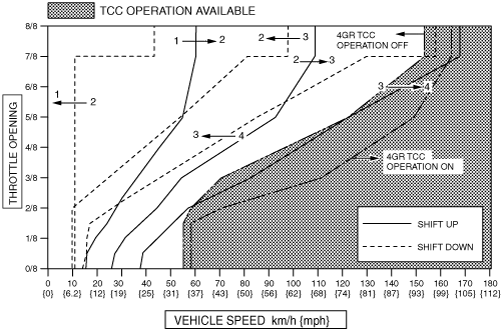 |
ROAD TEST[GF4AX-EL]
id051703802200
Road Test Preparation
1. Inspect the engine coolant level. (See COOLING SYSTEM SERVICE WARNINGS[L3].) (See ENGINE COOLANT LEVEL INSPECTION[L3].)
2. Inspect the engine oil level. (See ENGINE OIL LEVEL INSPECTION[L3].)
3. Inspect the ATF level. (See AUTOMATIC TRANSAXLE FLUID (ATF) INSPECTION[GF4AX-EL].)
4. Inspect the ignition timing. (See ENGINE TUNE-UP[L3].)
5. Inspect the idle speed. (See ENGINE TUNE-UP[L3].)
6. Bring up the engine and transaxle to normal operating temperature.
Shift Diagram
D range (normal mode)
atraaw00003094
|
D Range Test
1. Perform road test preparation. (See Road Test Preparation.)
2. Shift the selector lever to D range.
3. Accelerate the vehicle at half and wide open.
4. Verify that 1→2, 2→3, and 3→4 upshifts and downshifts are obtained. The shift points must be as shown in the table below. (O/D OFF switch off)
5. Verify that 1→2 and 2→3 upshifts and downshifts are obtained. (O/D OFF switch ON)
6. Drive the vehicle in 4GR, 3GR, and 2GR and verify that kickdown occurs for 4→3, 3→2, 2→1 downshifts, and that the shift points are as shown in the table below. (O/D OFF switch off)
7. Drive the vehicle in 3GR and 2GR and verify that kickdown occurs for 3→2, 3→1 downshifts. (O/D OFF switch ON)
8. Decelerate the vehicle and verify that engine braking effect is felt in 1GR and 2GR.
9. Drive the vehicle and verify that TCC operation is obtained. The operation points must be as shown in the table below.
Vehicle speed at shift point table
|
Range |
Mode |
Throttle condition |
Shift |
Vehicle speed (km/h {mph}) |
Turbine speed (rpm) |
|---|---|---|---|---|---|
|
D
|
NORMAL
(O/D OFF switch off)
|
Wide open
|
D1→D2
|
59—65 {37—40}
|
5,700—6,200
|
|
D2→D3
|
107—115 {67—71}
|
5,700—6,050
|
|||
|
D3→D4
|
164—174 {102—107}
|
5,650—5,950
|
|||
|
TCC ON (D4)
|
161—171 {100—106}
|
3,900—4,100
|
|||
|
Half open
|
D1→D2
|
40—49 {25—30}
|
3,800—4,750
|
||
|
D2→D3
|
63—83 {40—51}
|
3,300—4,400
|
|||
|
D3→D4
|
88—115 {55—71}
|
3,050—3,950
|
|||
|
TCC ON (D4)
|
116—143 {72—88}
|
2,800—3,400
|
|||
|
Closed
|
D4→D3
|
11—17 {7—10}
|
300—400
|
||
|
D3→D2
|
7—13 {5—8}
|
250—400
|
|||
|
D2→D1
|
8—14 {5—8}
|
450—700
|
|||
|
Kickdown
|
D4→D3
|
153—163 {95—101}
|
3,700—3,900
|
||
|
D3→D2
|
93—101 {58—62}
|
3,200—3,450
|
|||
|
D2→D1
|
40—46 {25—28}
|
2,150—2,400
|
2 Range Test
1. Perform road test preparation. (See Road Test Preparation.)
2. Verify that 2GR is held.
3. Decelerate the vehicle and verify that engine braking effect is felt.
1 Range Test
1. Perform road test preparation. (See Road Test Preparation.)
2. Verify that 1GR is held.
3. Decelerate the vehicle and verify that engine braking effect is felt.
P Position Test
1. Shift into P position on a gentle slope. Release the brake and verify that the vehicle does not roll.